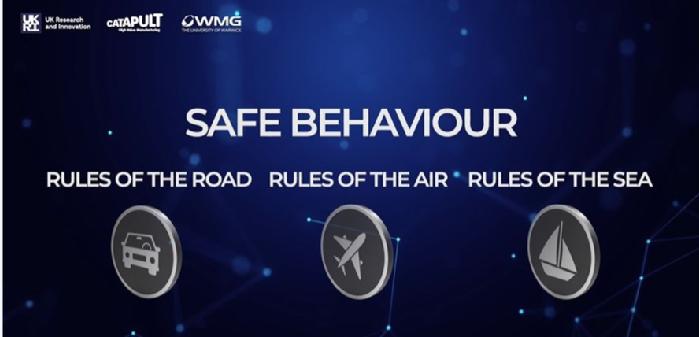WMG Insights
When it comes to safety, are facts enough?
Dr David Bott, Principal Fellow at WMG shares his insights from across the transport sector on how autonomous vehicle safety is perceived, and how we  will find the way to widespread acceptance and adoption
will find the way to widespread acceptance and adoption
Throughout this year, I have been taking part in a series of workshops on autonomous transport organised by the Verification and Validation Group at WMG, University of Warwick. The initial goal was to agree to work across the different transport domains (road, rail, sea and air) on a common safety framework. These workshops have provided insight into broad cross section of those involved in the various modes of autonomous transport. Different domains shared their experience and aims, and began to work out how to collaborate to achieve those aims faster. But, in addition, the evolving discussions have given us another, less tractable, goal.
Why Autonomy?
Enthusiasts for autonomous transport cite several reasons for its adoption. The first is greater efficiency of each individual unit of transport (car, train, ship, plane, etc.) as journeys can be planned and optimised. The second is greater efficiency of the whole system because journey can be planned interactively to avoid interruption and maximise overall flow. A future market value of £700 billion by 2030 is commonly cited. But safety is also a big factor in the argument for adoption. For example, over 1,700 fatalities occur on the roads in the UK, and we are a relatively safe country! Any reduction in that number would be worth having, and even more valuable in nations with more dangerous roads
How safe is safe?
In the workshops, the most interesting discussion came as the result of a question on customer uptake. To my ears, the question boiled down to whether having evidence that an activity was safe would make it more likely to be undertaken.
There was a sub-question as to whether suppliers should explain the risks associated with their new product. It was mainly focused on cars, but had wider implications – would we fly if we thought the airplane maker or carrier wasn’t safety conscious? One argument put forward was that, with any new activity, people start off cautious, but familiarity breeds confidence and the risks are ignored – until they have a scare, whereupon people go back to being cautious. Therefore, telling them the facts was largely irrelevant. The counter argument was that customers are becoming increasingly sophisticated. They are capable of, and more and more interested in, understanding the basis of how they might make their decision.
How customers make choices is complicated. It’s not always about price – the iPhone is a good example here. It’s also not always about safety – or else how do we explain the sales of hot hatches and sports cars?
Convenience plays a part. Brand plays a part. But the truth is there are probably as many reasons to buy something as there are people!
How much autonomy do we need?
Another complexity is that autonomy comes in degrees and uptake takes time. The first “autopilot” was developed in 1912 and kept planes flying straight and level. Landing (probably the riskiest bit), using autopilot was demonstrated in 1937 but not used on commercial flights until 1967. Similarly, “cruise control” in cars was first demonstrated in 1948 but did not become commonplace until the 1960’s. Lane control was first demonstrated in 1992 but not widely available until 2000.
The current rash of “self-driving” cars have been developed by companies large and small. They attract both praise (from the techies) and criticism (from sceptics) and both messages are amplified by the media (both institutional and social) with huge influence over consumer opinion.
A personal perspective
Full disclosure: I have owned a Tesla for over five years, and it comes equipped with the full suite of (sort of) autonomous systems. These systems cannot drive the car. There are two reasons for this. The first is (apparently) that due to UK regulations, Tesla have not allowed UK drivers to access the full software, although they keep promising that it is imminent. The second is that it feels to be aspirational in many aspects. It was developed principally for US freeway driving. In the form I have, it chokes on roundabouts, slows to a crawl to take corners the car can take at quite high speed in manual mode, and suffers from what is known in the community as “phantom braking”, where trees, bridges and objects it doesn’t recognise cause it to jam on the brakes. But it is easy to compensate for these idiosyncrasies, and these systems mostly make driving a more relaxing process. I can focus more on the road and potential obstacles, and any small distraction or lack of focus is “taken care of” by the system.
Passengers (after the obligatory demonstration of the acceleration of an electric drivetrain test) are always fascinated by it – that it even works to the level it does.
Choosing (and using) autonomy
We have driverless trains, most flights are largely autonomous, and aspects of marine transport use systems that perform similar functions to navigate and steer across the oceans. But cars seem to be different. We don't own trains, ships and planes. We assume that the responsible person – be they called driver or captain – will ensure that we are safe. We mostly own our own cars, and we drive them ourselves. Do we take the same level of care about road safety as those professionals? Those 1,700 people who die each year, and the many more who are injured, suggest not. Will autonomous cars be safer than human driven ones?
Whether we like it or not, the uptake of autonomy in personal transport is actually here – most modern cars have some level of driver assistance – but the uptake of complete autonomy, often characterised as “self-driving” cars is probably some way off and I suspect their “reputation” is a factor that needs to be addressed before they are commonplace.
I saw the same with electric vehicles 15 or so years ago. Critics looked to find faults, or reasons they would not work – range anxiety, lack of infrastructure, safety were all cited as reasons these cars would never take off, and the debate was not necessarily about facts, but opinions and beliefs. Nevertheless, sales grew slowly but steadily – mostly techies and early adopters. As they became more common, and people took rides in them, they became more accepted. More manufacturers made electric vehicles. Then the price of petrol went up markedly and sales climbed.
Open up the conversation
The challenge with autonomy is not about facts, it is about beliefs. The facts are necessary in the almost futile attempt to refute misinformation, but for most of us, the choice to travel in any form of autonomous transport is what we believe in, and acceptance begins with opening the conversation across all modes and users of transport.
Watch to gain more insight into the workshops: https://www.youtube.com/watch?v=1n4BZEJ3Tts&t=10s

Read WMG’s Report Cross Domain Safety Assurance Framework for Automated Transport Systems
If you are interested in learning more about WMG’s research into autonomous safety and how we work with businesses, please contact wmgbusiness@warwick.ac.uk
